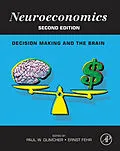Editors and contributing authors are among the acknowledged experts and founders in the field, making this the authoritative reference for neuroeconomics
Suitable as an advanced undergraduate or graduate textbook as well as a thorough reference for active researchers
Introductory chapters on economics, psychology, neuroscience, and anthropology provide students and scholars from any discipline with the keys to understanding this interdisciplinary field
Detailed chapters on subjects that include reinforcement learning, risk, inter-temporal choice, driftdiffusion models, game theory, and prospect theory make this an invaluable reference
Published in association with the Society for Neuroeconomics-www.neuroeconomics.org
Full-color presentation throughout with numerous carefully selected illustrations to highlight key concepts
Leseprobe
Preface
Since the publication of the first edition of this book, there has been an increasing institutional recognition of the importance of Neuroeconomics in the future of neuroscience, economics, and psychology. At the time that the first edition was published, just a handful of academic institutions included scientists engaged in neuroeconomic research, but the field has matured at an astonishing rate over the past 5 years. Today scholars at nearly a hundred institutions worldwide are at work on neuroeconomic problems and courses on neuroeconomics are now commonplace at both the graduate and undergraduate levels.
At the time that the first edition of this volume was published, it was also true that very little was known about the biological mechanism of human and animal decision making. Accordingly, the first edition was primarily designed to provide scholars interested in beginning to undertake neuroeconomic research with a strong interdisciplinary background in the area. Today, however, the landscape is quite different. Over the past 5 years the field of neuroeconomics has matured intellectually as well as institutionally. Thanks to the work of hundreds of cutting-edge scholars, we now know quite a lot about how and where decisions are made in the brain, and that is reflected in the structure of this second edition.
As we did in the first edition, we continue to believe that a strong interdisciplinary background is important for scholars in this area, but we now confine that review to the first section of the book. The second section presents what is known to date about the neural structure of preferences ranging from risk attitudes to social preferences, and to inter-temporal choice. The third section focuses on the learning of values and the neural systems central to our understanding of the neural representation of subjective value. Section 4 examines what is known about the choice process itself; the mechanism interposed between the valuation processes described in Section 3 and behavior. Section 5 expands on social studies of decision making, an important frontier in neuroeconomic research today. The book concludes with an appendix describing the prospect theory of Kahneman and Tversky in detail. It provides important practical information on the use of prospect theory in neuroeconomic experiments.
Using the BookOne of the critical challenges facing anyone interested in Neuroeconomics is the interdisciplinary nature of the science. To be a neuroeconomist one must be fluent in the languages of Economics, Psychology, Neuroscience, and (to a lesser degree) Primate Anthropology. We recognize that very few scholars or students will come to this book with a background in all of these areas, and the first section of the book is designed to address that constraint before the later sections of the book are encountered.
Section 1Accordingly, the first section of this book is broken into 4 components. Chapters 1 and 2 describe the theory and methods of experimental economics. For someone trained in economics these chapters would be entirely superfluous. They are intended for neurobiologists and psychologists who are trying to get a handle on economic thought as a preparation for the second through fifth sections of the book. For someone who knows a little economics but who has not been formally trained in economics, these two chapters are essential. Chapters 3 and 4 (along with the appendix) provide a survey of the psychology of Judgment and Decision Making. These chapters should be of particular value to economists and neuroscientists unfamiliar with that tradition. Chapters 5 and 6 are designed to provide basic literacy in the fundamental methodologies of neuroscience for non-neuroscientists. Social scientists who hope to make sense of the empirical chapters that follow are urged to take pa
Inhalt
Foreword
Introduction
Section 1: The Fundamental Tools of Neuroeconomics
1. Basic Methods from Neoclassical Economics
2. Experimental Economics and Experimental Game Theory
3. Computational Models of Decision-Making from Psychology and Behavioral Economics
4. Estimation and Testing of Computational Models
5. Computational Neuroscience
6. Experimental Methods in Cognitive Neuroscience
7. The Economics of Non-Human Primates
Section 2: Risk, Time, Social and Emotional Preferences
8. Computation of value in simple choices
9. Valuation for Risky and Uncertain Choices
10. Valuation, Intertemporal Choice and Self Control
11. Neuroeconomics of Social Preferences
12. The Study of Emotion in Decision Making
13. Valuation and Common Neural Currencies
14. The pharmacology of economic and social decision-making
Section 3: Learning and Valuation
15. Value Learning through Reinforcement: The Basics of Dopamine and RL
16. Advanced Issues in Reinforcement Learning
17. The Basal Ganglia, Reinforcement Learning and The Encoding of V…
